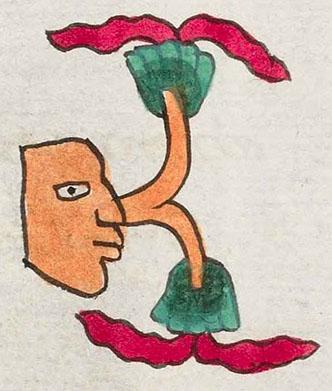Huaxyacac (Mdz44r)
This compound glyph for the place name Huaxyacac shows a face (xayacatl), and the nose (yacatl) has a bifurcated plant growing out, then up and down, from it. The face is in profile and colored terracotta. The eye is open. The stems of the plant are also terracotta colored. At the end of each of the two stems appears some two-tone green foliage and, emerging from that are two red seed pods, one running horizontally to the right and the other to the left. The plant is the huaxin, which is a tropical tree with edible seed pods. The final locative suffix (-c) is not shown visually.
Stephanie Wood
Here, the nose is figurative for a geographical feature, such as a peak or a point. The locative suffix (-c) here joins with yaca- to mean "at the point" or "on the ridge." In Whittaker's transliteration, we see the "xayaca" of the face superscripted because it is not playing a direct role in the phonetics of the place name. Rather, it is underlining the reading of the other components. It is what Whittaker calls a "phonetic indicator." And the overlap in the reading of the elements is "graphic Syllepsis." Kasia Mikulska, in a presentation at the Library of Congress (4/18/2023) suggests that the bifurcation in the plant may be a subtle reference to the term maxactli, something forked, which shares something of the sound of this place name.
Stephanie Wood
guaxacac. puo
Huaxyacac, pueblo (today, Oaxaca)
Stephanie Wood
c. 1541, but by 1553 at the latest
Stephanie Wood
points, peaks, puntas, picos, guajes, caras, faces, narices, noses, seed pods, vainas de semillas, nombres de lugares

huax(in), a tropical tree with edible pods, https://nahuatl.wired-humanities.org/content/huaxin
yaca(tl), nose, https://nahuatl.wired-humanities.org/content/yacatl
maxac(tli), a fork, a bifurcation, https://nahuatl.wired-humanities.org/content/maxactli
-yacac (locative suffix) at the point or on the ridge https://nahuatl.wired-humanities.org/content/yacac
xayaca(tl), face, https://nahuatl.wired-humanities.org/content/xayacatl
"Huaxin Ridge" [Frances Karttunen, unpublished manuscript, used here with her permission.]
"At Guaje Point" [Gordon Whittaker, Deciphering Aztec Hieroglyphs, 2021, 106]; "Where the Huaxin Trees Begin" (Berdan and Anawalt, 1992, vol. 1, p. 187)
HUAX-YACAxayaca•
Codex Mendoza, folio 44 recto, https://digital.bodleian.ox.ac.uk/objects/2fea788e-2aa2-4f08-b6d9-648c00..., image 98 of 188.
The Bodleian Libraries, University of Oxford, hold the original manuscript, the MS. Arch. Selden. A. 1. This image is published here under the UK Creative Commons, “Attribution-NonCommercial-ShareAlike 3.0 License” (CC-BY-NC-SA 3.0).







